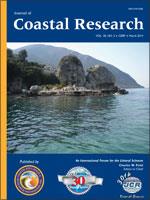Hernández-Azcúnaga, L.; Carbajal, N., and Montaño-Ley, Y., 2014. Bedload transport of sediments and morphodynamics in the northern Gulf of California.
Huge amounts of sediments have been supplied to the northern Gulf of California in recent geological time. Although water discharge and sediment supply have been suppressed from the Colorado River since about a century, satellite imagery reveals even now a persistently strong mobilization of sediments and the occurrence of marked sea bottom morphological features. To gain information on these processes, we applied a two-dimensional hydrodynamic numerical model to simulate bedload sediment transport caused by the dominant semidiurnal tidal component, M2, in the northern Gulf of California. The resulting transport of sediment encompasses areas of the Colorado River Delta, of the Adair and San Jorge bays, and of the southwestern sector of the study area. The model reproduces longitudinal and transversal bedforms observed in Adair Bay. The residual bedload transport reveals recirculation processes that retain sediments in the Colorado River Delta, and in the bays of Adair and San Jorge. Sediment dynamics occur in areas where tidal currents exceed the threshold velocity, where the incident tidal wave is reflected, and where Poincare waves are generated. This calculated general picture is consistent with satellite images depicting morphological features and mobilization of sediments. The production of bedforms coincides with theoretical predictions on the reflection and diffraction of Kelvin waves at closed boundaries and corners. Sediments mobilization and bedforms in the northern Gulf of California are strongly controlled by tidal dynamics.





